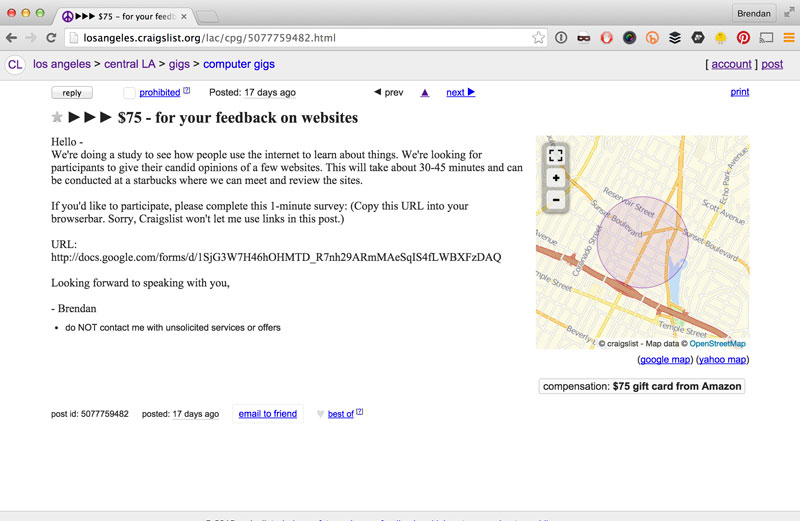In an agency, you often have the luxury of money, allowing you to hire a facility and access a database of pre-screened candidates, you can query against to find people who match your participant criteria.
But when you are doing it on your own, that’s not a real option for you because of the high cost.
Here’s a brief overview of the DIY process I use to recruit and screen participants for user testing sessions, which I conduct as a startup/freelance hustler:
First, figure out your the goals of your research and what you want to learn. (A great way to do this is to make yourself a Testing Plan ).
Then post an ad on craigslist for participants in a web study. In your post ask people to fill out a “quick form”, review the form as people enter their information, and follow up with the ones who meet your criteria.
Here’s a real world example:
I needed to recruit people for user research on a life insurance site, so I posted this ad, offering people a gift card (which is tax deductible, because it’s a gift) in exchange for 30-45 minutes at a mutually convenient Starbucks.
Here’s the ad I posted:

Here’s a link to the live screener I used. Google allows you to create forms with some conditional logic to make your intentions less obvious, which is helpful. Here’s a PDF so you can see behind the curtain how I constructed that logic.
I was looking for the following:
People who might actually buy our life insurance product:
- People either married and/or with kids
- 25 – 44 years old
- 40k-90k individual income (if they made more, we couldn’t issue a policy big enough for them.)
- People who didn’t have any bad biases against life insurance (hence the “Why don’t you have it?”)
People who didn’t have life insurance were preferable, but hard to find, so about half of our participants ended up actually already having it, and that wasn’t a problem. We also ended up accepting people with a little less/more annual incomes, because they were good matches with the other criteria. I’ve pasted some example responses here so you can see what the survey data looks like as people fill it out. (The green one is an example of what we were looking for. The yellow one was not optimal, but was usable.)
Protips:
You’ll notice in the screener there are questions we don’t care about at all, like if they have home/renters insurance. Questions like that were just there so that it wouldn;t be too obvious that we were focused on life insurance. (For instance, if you only ask a person who wants to get paid “Do you have life insurance?” they might fill out the form twice and answer “Yes” once and “No” the second time.
You can also google the email address the person gives you and see if anything scandalous comes up. Ha! (I have found out several rascals this way.)
Hope this was helpful. Please let me know!